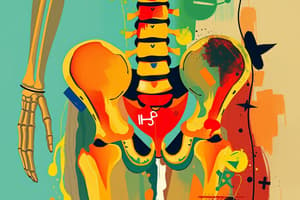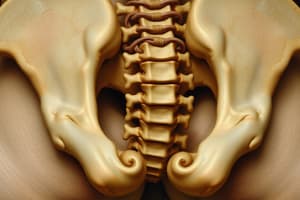Podcast
Questions and Answers
What percentage of pelvic injuries occur in men?
What percentage of pelvic injuries occur in men?
- 90%
- 50%
- 75% (correct)
- 100%
Haemorrhage is the leading cause of death in 40% of pelvic trauma patients.
Haemorrhage is the leading cause of death in 40% of pelvic trauma patients.
True (A)
Name one mechanism that can cause pelvic injuries.
Name one mechanism that can cause pelvic injuries.
High energy transfer, Fall from height, or Crush injury
Pelvic fractures represent _____ of all fractures in adults.
Pelvic fractures represent _____ of all fractures in adults.
Match the following causes of pelvic injuries with their descriptions:
Match the following causes of pelvic injuries with their descriptions:
What is a common complication resulting from pelvic fractures?
What is a common complication resulting from pelvic fractures?
Urogenital injuries, such as bladder rupture, are uncommon in pelvic trauma cases.
Urogenital injuries, such as bladder rupture, are uncommon in pelvic trauma cases.
In polytrauma cases, what percentage do pelvic fractures represent?
In polytrauma cases, what percentage do pelvic fractures represent?
Which of the following is NOT a sign of pelvic injuries?
Which of the following is NOT a sign of pelvic injuries?
A pelvic splint can be removed after it has been applied.
A pelvic splint can be removed after it has been applied.
What is the primary goal in managing catastrophic hemorrhage in pelvic injuries?
What is the primary goal in managing catastrophic hemorrhage in pelvic injuries?
Pelvic injuries can lead to fatal __________.
Pelvic injuries can lead to fatal __________.
Match the symptoms of pelvic injuries with their descriptions:
Match the symptoms of pelvic injuries with their descriptions:
What is the first action to take when treating a patient with a pelvic injury?
What is the first action to take when treating a patient with a pelvic injury?
Minimizing movement is important when treating pelvic injuries.
Minimizing movement is important when treating pelvic injuries.
List two methods of managing pelvic injuries at the scene.
List two methods of managing pelvic injuries at the scene.
What is the most common cause of spinal injuries?
What is the most common cause of spinal injuries?
Spinal shock can result in both loss of motor and sensory functions.
Spinal shock can result in both loss of motor and sensory functions.
Name one type of spinal injury.
Name one type of spinal injury.
Spinal injuries can also be caused by _______ or vascular thrombosis.
Spinal injuries can also be caused by _______ or vascular thrombosis.
Which condition requires urgent decompression due to severe nerve compression?
Which condition requires urgent decompression due to severe nerve compression?
Neurogenic shock results from loss of sympathetic tone.
Neurogenic shock results from loss of sympathetic tone.
Describe a common sign or symptom of spinal injury.
Describe a common sign or symptom of spinal injury.
Symptoms such as ________, bladder dysfunction, and lower limb weakness indicate severe spinal issues.
Symptoms such as ________, bladder dysfunction, and lower limb weakness indicate severe spinal issues.
Match the following mechanisms of spinal injury with their description:
Match the following mechanisms of spinal injury with their description:
Which of the following complications can result from spinal injuries?
Which of the following complications can result from spinal injuries?
Only traumatic events lead to spinal injuries.
Only traumatic events lead to spinal injuries.
What percentage of spinal injuries result from sporting injuries?
What percentage of spinal injuries result from sporting injuries?
The presence of lower limb weakness and ________ may indicate spinal injury.
The presence of lower limb weakness and ________ may indicate spinal injury.
How long can spinal shock potentially last?
How long can spinal shock potentially last?
Compression of the spinal cord can happen due to vertebral displacement.
Compression of the spinal cord can happen due to vertebral displacement.
Flashcards are hidden until you start studying
Study Notes
Pelvic Injuries
- Pelvic fractures account for 3-6% of all adult fractures and occur in 20% of polytrauma cases.
- 75% of pelvic injuries are observed in men; haemorrhage contributes to 40% of fatalities in pelvic trauma cases.
- Major causes include high-energy transfers like road traffic collisions (RTCs), falls from height, and crush injuries. Elderly patients and those with bone degenerative diseases or receiving radiotherapy are at heightened risk from simple falls.
- Key signs and symptoms include:
- Bruising, deformity, swelling, and pain around the hips, groin, or lower back.
- Signs of hypovolemic shock and altered sensation in one leg.
- Bleeding from rectal, vaginal, or urethral areas, along with limb shortening.
- Complications can result from increased pelvic volume leading to haemorrhage, vascular injuries, and urogenital injuries (such as bladder rupture in 10% of cases).
Management of Pelvic Injuries
- Immediate management protocols emphasize time sensitivity; use the DRABC approach (Danger, Response, Airway, Breathing, Circulation) and apply pelvic splints.
- Control any catastrophic haemorrhage, administer high-flow oxygen, and ensure smooth transfer to major trauma centers (MTC).
- Avoid excessive movement; once a pelvic splint is applied, it should not be removed to maintain stabilization.
- Pelvic splints are single-use and adjustable for patients of various sizes, fitting pediatric to bariatric individuals.
Spinal Injuries
- Spinal injuries commonly result from hyperflexion, hyperextension, rotation, or compression forces. Falls account for 46%, with 40% stemming from RTCs.
- Types of spinal injuries include vertebral dislocation, fracture, and displacement, which can lead to spinal cord injury (SCI).
- Other contributing factors include spinal tumors, vascular issues (thrombosis or hemorrhage), infections, and abscesses.
- Complications of spinal injuries include damage or compression of the spinal cord, leading to conditions like spinal shock, neurogenic shock, respiratory difficulties, and Cauda Equina Syndrome (CES).
Cauda Equina Syndrome (CES)
- CES involves severe compression/inflammation of spinal nerves in the low spinal canal, necessitating urgent decompression.
- Symptoms may develop quickly (hours/days) or slowly (chronic).
- Clinical red flags indicating CES include saddle anesthesia, bladder/bowel dysfunction, sexual dysfunction, and lower limb weaknesses.
Signs & Symptoms of Spinal Injury
- Common indicators of spinal injuries include:
- Pain throughout the spine (neck or back), loss of sensation/movement in limbs, altered sensation (pins and needles, burning).
- Associated symptoms might indicate the level of injury, such as hypotension, which may occur as a result.
Studying That Suits You
Use AI to generate personalized quizzes and flashcards to suit your learning preferences.




